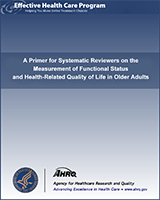NCBI Bookshelf. A service of the National Library of Medicine, National Institutes of Health.
Structured Abstract
Objectives:
Provide a primer for systematic reviewers, clinicians, and researchers on assessing functional status and health-related quality of life (HRQL) in older adults. Systematic reviewers are increasingly focusing on interventions that address the problems of older people, who often have functional impairments and multiple morbidities. Key outcomes are function and HRQL. The paper provides an overview of the methods for assessing function and HRQL, and evidence on the measurement properties of prominent measures.
Methods:
The paper provides an overview of the methods for assessing function and HRQL, and evidence on the measurement properties of prominent instruments.
Results:
Key measurement properties include construct validity (does the instrument measure what it is supposed to measure?), responsiveness (the ability to detect meaningful change) and interpretation (is the magnitude of change trivial or important?). Special challenges in older adult populations include sometimes sparse evidence on the measurement properties; using proxy respondents; a paucity of evidence on the magnitude of change that is patient-important; and threats to detecting patient-important changes due to floor and ceiling effects.
Discussion:
While further study of the measurement properties of measures in older populations is needed, studies of older adults should include measures of HRQL and function. Further, to generate rigorous evidence on effectiveness, older adults should be included in randomized controlled clinical trials. HRQL evidence from natural-history cohorts is important in interpreting results from intervention studies.
Contents
- Preface
- Acknowledgments
- Peer Reviewers
- Introduction
- Patient-Reported Outcomes, Health-Related Quality of Life, and Function: An Overview of Measurement Properties
- What To Assess and How To Interpret Measures of Functional Status and Health-Related Quality of Life
- Implications for Researchers
- Implications for Systematic Reviewers
- Summary and Conclusions
- References
- Appendix A Measurement Properties
Prepared for: Agency for Healthcare Research and Quality, U.S. Department of Health and Human Services1, Contract No. 290-2007-10057-I. Prepared by: Kaiser Permanente Research Affiliates Evidence-based Practice Center, Center for Health Research, Portland, OR
Suggested citation:
Feeny DH, Eckstrom E, Whitlock EP, Perdue LA. A Primer for Systematic Reviewers on the Measurement of Functional Status and Health-Related Quality of Life in Older Adults. (Prepared by the Kaiser Permanente Research Affiliates Evidence-based Practice Center under Contract No. 290-2007-10057-I.) AHRQ Publication No. 13-EHC128-EF. Rockville, MD: Agency for Healthcare Research and Quality. September 2013. www.effectivehealthcare.ahrq.gov/reports/final.cfm.
This report is based on research conducted by the Kaiser Permanente Research Affiliates Evidence-based Practice Center (EPC) under contract to the Agency for Healthcare Research and Quality (AHRQ), Rockville, MD (Contract No. 290-2007-10057-I). The findings and conclusions in this document are those of the authors, who are responsible for its contents; the findings and conclusions do not necessarily represent the views of AHRQ. Therefore, no statement in this report should be construed as an official position of AHRQ or of the U.S. Department of Health and Human Services.
The information in this report is intended to help health care decisionmakers—patients and clinicians, health system leaders, and policymakers, among others—make well informed decisions and thereby improve the quality of health care services. This report is not intended to be a substitute for the application of clinical judgment. Anyone who makes decisions concerning the provision of clinical care should consider this report in the same way as any medical reference and in conjunction with all other pertinent information, i.e., in the context of available resources and circumstances presented by individual patients.
This report may be used, in whole or in part, as the basis for development of clinical practice guidelines and other quality enhancement tools, or as a basis for reimbursement and coverage policies. AHRQ or U.S. Department of Health and Human Services endorsement of such derivative products may not be stated or implied.
David H. Feeny has a proprietary interest in Health Utilities Incorporated, Dundas, Ontario, Canada. HUInc. distributes copyrighted Health Utilities Index (HUI) materials and provides methodological advice on the use of HUI. None of the other investigators have any affiliations or financial involvement that conflicts with the material presented in this report.
- 1
540 Gaither Road, Rockville, MD 20850; www
.ahrq.gov
- NLM CatalogRelated NLM Catalog Entries
- Review Screening for Cognitive Impairment in Older Adults: An Evidence Update for the U.S. Preventive Services Task Force[ 2013]Review Screening for Cognitive Impairment in Older Adults: An Evidence Update for the U.S. Preventive Services Task ForceLin JS, O'Connor E, Rossom RC, Perdue LA, Burda BU, Thompson M, Eckstrom E. 2013 Nov
- Review A structured review of studies on health-related quality of life and economic evaluation in pediatric acute lymphoblastic leukemia.[J Natl Cancer Inst Monogr. 2004]Review A structured review of studies on health-related quality of life and economic evaluation in pediatric acute lymphoblastic leukemia.Pickard AS, Topfer LA, Feeny DH. J Natl Cancer Inst Monogr. 2004; (33):102-25.
- Review Screening and Interventions for Childhood Overweight[ 2005]Review Screening and Interventions for Childhood OverweightWhitlock EP, Williams SB, Gold R, Smith P, Shipman S. 2005 Jul
- A taxonomy of health status instruments.[J Rheumatol. 1995]A taxonomy of health status instruments.Guyatt GH. J Rheumatol. 1995 Jun; 22(6):1188-90.
- Review Measuring Health-Related Quality of Life for Patients with Diabetic Retinopathy[ 2012]Review Measuring Health-Related Quality of Life for Patients with Diabetic RetinopathyMilne A, Johnson JA, Tennant M, Rudnisky C, Dryden DM. 2012 Apr 23
- A Primer for Systematic Reviewers on the Measurement of Functional Status and He...A Primer for Systematic Reviewers on the Measurement of Functional Status and Health-Related Quality of Life in Older Adults
Your browsing activity is empty.
Activity recording is turned off.
See more...
